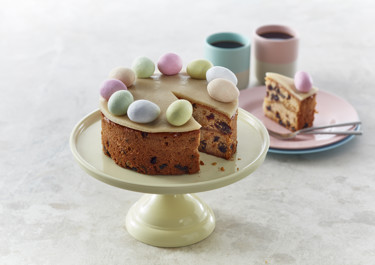
Simnel cake

Instructions
Cake
Topping
Tips
This type of cake requires a long, slow bake. To prevent the top from over-browning, you may need to cover it loosely with foil halfway through baking. Due to its dense nature, use a skewer or cake tester inserted into the centre of the cake to check for doneness. If it comes out clean, the cake is fully baked.
Tips
Simnel cake is an excellent choice for making ahead as its flavours deepen and mature over time. You can make it 2-4 weeks before Easter to let it develop its flavours and texture, which also lets you spread out your Easter preparations. If you are short on time, making the cake even 1 week in advance will still benefit its overall flavour and texture. However, you should add any fresh decorations just before serving.
Questions about Simnel cake
Do you want to know more about this traditional Easter cake? Below, we answer a few of the most commonly asked questions about simnel cake so you can get to know everything before you start baking.
Ingredients
Cake
|
Soft butter or spreadable
|
180 g |
|---|---|
|
Sugar
|
180 g |
|
Wheat flour
|
180 g |
|
Eggs
|
3 |
|
Cinnamon
|
1 tsp |
|
Salt
|
½ tsp |
|
Orange (unsprayed), finely grated zest
|
1 |
|
Raisins and/or cranberries
|
175 g |
|
Candied orange peel, in small pieces
|
100 g |
|
Marzipan
|
150 g |
Topping
|
Apricots jam
|
100 ml |
|---|---|
|
Marzipan
|
150 g |
|
Easter eggs
|
11 |
Celebrate Easter with a traditional simnel cake
Easter is a time for traditions, so why not go all out? This simnel cake dates way back and is the essence of Easter with its traditional decorations and zesty, fruity, springtime flavours. Make this for your Easter celebrations, impressing your guests with a moist and flavourful cake that has deep roots in the history of Easter. From top to bottom, it is full of flavours from sweet, nutty marzipan, tangy and sweet apricot jam, and various dried, fresh, and candied fruits and berries.
A moist Easter cake with orange flavour
Easter simnel cake stands out with its vibrant orange flavour, provided by finely grated zest and candied peel. They imbue the cake with a refreshing citrus aroma and flavour. Raisins and/or cranberries complement the orange notes, adding bursts of sweetness and tartness that enhance the moisture and complexity of the cake. This creates a rich, fruity profile, making each slice irresistibly moist and infused with a subtle, yet distinct orange essence.
A layer of marzipan in the middle
A layer of marzipan is baked into the fruity cake batter. It enriches the cake with a moist, almond-flavoured sweetness that permeates each slice, enhancing the overall flavour profile with its rich, nutty essence. The marzipan layer introduces a soft, slightly chewy contrast to the dense, fruit-laden cake. The layer melds with the other ingredients during baking, ensuring that the almond flavour subtly infuses the cake, balancing the sweetness of the fruits and the depth of the spices.
Completed with apricot jam and a marzipan lid
The cake has a finishing sweet and fruity touch to complement the dried fruit and baked marzipan layer. The jam enhances the cake's moisture and introduces a subtle, fruity sweetness to balance the richness of the marzipan and the dense, spiced fruitcake beneath. The marzipan lid introduces a rich almond sweetness and a luxurious texture, balancing the spiced fruitcake's complex flavours and the apricot jam's tartness. And, of course, it creates the layer on which the classic Easter eggs or marzipan balls will be.
A symbolic decoration – the history of simnel cake
Simnel cake is a traditional fruitcake usually eaten during Easter in the United Kingdom and Ireland. The long history of simnel cake dates back to medieval times, and it is known for its layers of marzipan and marzipan balls on top. Traditionally, there are 11 balls representing the apostles, excluding Judas because he betrayed Jesus. Some variations include a 12th ball to represent Jesus Christ, depending on the cultural or family tradition. The 11 Easter eggs in this recipe are the final touch of the fruitcake. They are a central part of the symbolism of the cake and contribute to the look as well. You can use chocolate Easter eggs or shape balls of marzipan, depending on your preferences.
Make a personal Easter simnel cake
For a richer flavour, consider soaking the dried fruit in orange juice or a splash of brandy overnight. This will plump up the fruit and add moisture to the cake. If you want a decorative, toasted finish on the marzipan, use a kitchen torch to brown the marzipan slightly. Watch closely to ensure it browns evenly without burning. Its slight toasting enhances the nutty almond flavour, adding depth and a hint of caramelisation. The traditional recipe calls for cinnamon, but feel free to experiment with other spices such as nutmeg, mixed spice, or allspice to add depth and warmth to the flavour profile. If you want to try other recipes for Easter cakes, have a look at this one for Easter bunny cake or this one for Swiss carrot cake, also known as Rüblitorte .

&format=jpg)
&format=jpg)


&format=jpg)
&format=jpg)
